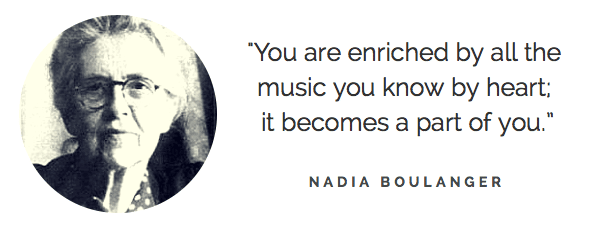There’s a secret hidden in every great solo. You’ll find it in those old records of Louis Armstrong and those videos of Bird and Diz that you watch on YouTube. You can even hear it in the players of today like Terence Blanchard, Kurt Rosenwinkel, Tom Harrell and dozens of others. It’s a secret that not many people even think about, let alone talk about. But it’s there if you really look for it.
Still guessing? Well I’ll tell you right now that it’s not a fancy scale, not a music theory trick, and it’s not the lick.
You might even think it absurd that there is anything more to a solo that the actual notes. I know I did until I started digging into the solos of my favorite improvisers.
But keep reading because this secret will change the way you approach improvisation…
Shhhhh!
The secret is this:
Behind one line of a great solo lies the weight of a thousand hours of practice. Years of listening. Dozens of transcribed solos. Decades of private instruction. Tough lessons picked up in jam sessions and revelations passed on by mentors.
…all in just a dozen notes.
Think about it: all of the practice on technique, all of that work on sound, every gig and every hour of study led to that solo you just listened to. It’s all there hidden in those notes.
These notes could fly right by you if you’re not paying attention. You might hear it and brush it off as just another solo from a talented improviser, but stop!
These notes have the answers you’ve been searching for. Every articulation, every rhythm, every note choice and every beat of silence holds weight.
Just as each cell of a living organism contains the DNA for that being, each note choice, articulation, and sound contains the DNA of that player. Who they listened to, what they studied, what they were thinking, and how they applied their musical concepts.
Beyond the world of music theory and the idea of talent lies the things that made these players truly great. This is why learning something by ear is so powerful – it’s the importance of transcribing.
Let me explain…
The power of one musical idea
Take a listen to Charlie Parker’s first chorus on Cherokee:
On first impression it probably sounds antiquated. Another classic Bird solo, what’s the big deal?
But dig in deeper. What you can’t catch on your first listen, you’ll discover as you spend time figuring out each note.
Instead of tackling the entire solo, start with just a single phrase. It might take 3 or 4 tries to get the notes right, you might have to spend 20 minutes on one line, and you may want to run out of the room screaming in frustration.
However, for those who step up to the challenge, the secrets are slowly revealed.
As you work on this one phrase, slow it down and figure it out note by note. You should feel like a scientist running an experiment or an explorer embarking on a journey. You’re searching day and night for the hidden secret of why this solo works.
Remember, every line of this solo holds the secret of Bird’s magic. One group of notes reveals his search for a new sound, his interest in new harmonies, his process of learning and innovating, another his approach to time and swinging and his process for connecting chords and navigating harmonies
All in a phrase that flies by in seconds! It’s not just talent or scales and licks that made this solo great, by getting closer to the music and learning it by ear you’ll discover what made an improviser like Parker tick – the secrets behind the notes.
If you’ve never approached music like this it can be mind-blowing. The more you focus the more you’ll discover. You are getting inside these players’ hearts and minds, each phrase is an artistic “ah-ha” moment.
So value these notes, they are worth their weight in gold.
The easy way or the right way?
All of this makes sense, but there is a catch.
If the secret to lies in figuring out the notes, I mean why not just get this information from a book of transcribed solos? All of the information will be right there on the page, right?
Here’s the thing – it’s not. Not even close.
You see the secret behind the solo is not in that book. It’s on the recording, you have to get it from the musician themselves.
It’s only when you turn on the music and listen with all of your attention that you begin to notice the secrets that made this player truly great. Through imitation you gain the most musical benefit.
Treat each line with importance. These players spent years developing the skills to create this solo, so put in the time to learn them correctly, note by note from the record.
All of the work is done by you and all the benefit is gained by you.
Now make it a part of you
If you want to play great solos and reach your creative potential, you need to have this music coursing through your veins.
And the only way to do this is by ingraining these notes into your ear, into your muscles and into your mind on an intimate level.
Imagine walking into a restaurant so hungry that you can barely stand and impatiently ordering a cheeseburger. However, instead of eating it as soon as it comes out of the kitchen, you just sit there staring at it thinking about the ingredients and speculating what the chef did to make it.
Sound weird? Well this is exactly what you’re doing when you try to learn a solo from a piece of paper without listening to it.
Want to satisfy your musical hunger? Then stop looking at the notes on a page and thinking about scales and music theory. You need to grab that solo with your bare hands and take a big bite. Chew it for awhile and figure out each of the different textures and flavors in there and then absorb every drop of those musical nutrients.
So what are you waiting for, grab a fork and knife and turn on your favorite solo!
Take that one phrase that you thought nothing of on your first listen. Now that you’ve figured it out, discovered its importance, and had that “ah-ha” moment you need to make it a part of your own playing.
Learn it in every key and repeat it until you have mastered every little nuance of that line.
By learning this one phrase you’ll may gain some ii-V7 language, an approach to V7 chords, an articulation, a way to phrase a line, a rhythmic approach, a harmonic or melodic tool, an approach to sound or expression – the possibilities are endless.
Now it’s your turn
Transcribing often feels like an insurmountable task.
I’m right there with you.
But don’t despair, you don’t have to transcribe hundreds of solos to learn how to improvise. Developing useful language starts with just one line, one musical phrase that you learn by ear.
And the benefit of this one phrase is huge because it contains all of the musician’s life and practice and influences up to that point. This is the secret that most players miss because they’re only thinking about getting the notes – don’t let this be you.
Remember, the catch with transcribing is that no one can do it for you.
A book can’t do it for you, your teacher can’t do it for you, and your favorite website can’t do it for you.
You have to go into that room alone. You have to be the fearless explorer sneaking into the forbidden temple at night. You must grab that prized jewel all by yourself.
So get ready. Your answers are waiting for you, the secrets are hidden in your favorite solos…now go find them!











